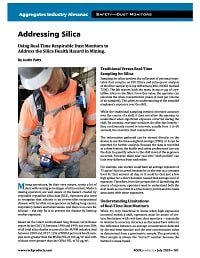Mining Publication: Using Real-Time Respirable Dust Monitors to Address the Silica Health Hazard in Mining
Original creation date: July 2020
Authors: J Patts
Mining operations, by their very nature, create a lot of dust, with varying percentages of silica content. Modern mining operators are well aware of the hazard created by respirable crystalline silica dust (RCS). Operators also need to recognize that silicosis is an irreversible occupational disease with terrible consequences including lung cancer, respiratory failure and tuberculosis. And there is no cure for silicosis – the only fix is to prevent the disease by limiting worker exposure.
Based on the latest work-related lung disease surveillance report by the CDC, between 1990 and 1999, just over 20% of all total silica deaths occurred in the M/NM industry. And between 2000 and 2017, 12% of MSHA personal heath samples were greater than the MSHA PEL of 100 µg/m3 and 34% of those were greater than the OSHA PEL of 50 µg/m3.

- Analysis of the Silica Percent in Airborne Respirable Mine Dust Samples from U.S. Operations
- Control of Respirable Dust
- Equivalency of a Personal Dust Monitor to the Current United States Coal Mine Respirable Dust Sampler
- Filter Media and Holder Compatible with Personal Dust Monitor and End-of-Shift Crystalline Silica Quantification by Raman and FTIR Spectroscopy
- Improving Silica Dust Control Through Targeted Research
- Laboratory and Field Performance of a Continuously Measuring Personal Respirable Dust Monitor
- Laboratory Evaluation of Pressure Differential-based Respirable Dust Detector Tube
- Reducing Silica and other Respirable Hazards in the Industrial Minerals and Metal/Nonmetal Mining Industries
- Respirable Dust
- Silica Adds to Respirable Dust Concerns: What If You Could Know the Silica Dust Levels in a Coal Mine After Every Shift?